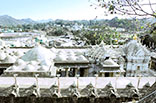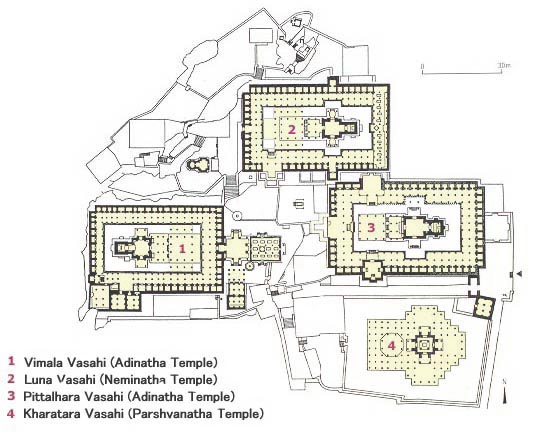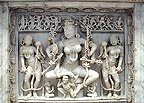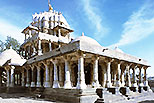|
THE DELWARA TEMPLES
|
TAKEO KAMIYA
|
THE DELWARA TEMPLES
|
While I was traveling in Gujarat which is in West India, I caught a cold and covered my mouth with a white mask and walked around the town of Ahmadabad. People passing by looked at me surprisingly and some impolite young people pointing at me burst into laughter. There are many followers of Jainism in West India. However, since Jainas account for only 0.5% of the total Indian population, they are still a minority. The most important teaching of Jainism is "Ahimsa," meaning non-violence or non-killing. Ahimsa is applied not only for humans, but also for all sentient beings. Jainas even avoid claiming the lives of insects. The precepts that Jaina monks should follow are very strict. When they travel on foot for ascetic practices and preachment during the dry season, they carry brushes in their hands and wear masks. They make it a rule to brush away surfaces of stones before sitting down on them in order to avoid stamping on insects. To wear a mask is for fear of biting small flying insects unwittingly when opening their mouths carelessly.
Lay followers, however, seldom keep such harsh precepts. The young people in Ahmadabad laughed at me because they thought that a foreigner infected with Jainism was practicing such an anachronism.
 
There are lots of Jaina temples in both states of Gujarat and Rajasthan in West India. The most famous ones among them are the Delwara (*2) temples. They are situated at Mt Abu (*1) , which is 170km north of Ahmadabad and 1,200m above sea level. The mountain has been worshipped by Hindu Shivaites and Jainas since ancient times. After the construction of this group of temples, Mt. Abu became a very significant pilgrimage site for Jainas as well as Mt. Satrunjaya. The Delwara temples consist of four temples of similar size and one small temple (*3) . Although each temple has symmetrical plan, there is no axis that runs through this group of temples as a whole. Space surrounding the temples seems just a residuary, and does not form a public square. This lack of totality could be partly because each temple was added one after another with an interval of about a century, and also because the desire for city or regional planning of Indian people was not so strong before the advent of Islam. Consequently, despite the fact that this group of temples is situated across a vast area, pilgrims would not feel any strong impression upon their approach to the site.
 Plan of the Derwara temples In addition to that, since most of the temples are single-storied structures, there is not a tall tower which can be seen from outside, and the surrounding walls of each temple are not attractive at all. In short, it does not show any beauty in external appearance. One might feel dubious if these are the famous Jaina temples. But upon entering the temples, there is another world that takes our breath away. Two temples are especially stunning. One is Vimala Vasahi (*4) , which is dedicated to Adinatha, the first Tirthankara or Jina (*5) . The other is Luna Vasahi, dedicated to Neminatha, the 22nd one. The interior space of both temples is made of white marble. Everywhere except the floors, from walls to ceilings as well as columns and beams, are covered with extremely delicate engravings. This white and pure space is so gorgeous that it makes us feel as if we are out of this world. Above all a Domical ceiling of "Ranga mandapa" (open-type hall) is carved concentrically with utmost intricacy. The central part of it is sagging like a chandelier made of stalactite. Sixteen bodies of "Vidyadevi" (goddesses of knowledge) are also engraved on the vault. It is hard to believe that all of them are made of stone.

It is a feast for the eyes to watch from amongst pillars, each one of them carved with different designs, the intertwined interior and exterior space lit up by reflecting sunlight that comes from courtyards. Every part of ceiling at "bhamati" (cloisters) which surrounds "Vimana" (main shrine) is also covered with carvings such as lotuses, gods, and abstract patterns. In each external "deva-kulikas" (small shrines) that face the bhamati, a statue of Tirthankara (Jina) is installed. According to a legend, sculptors conducted their jobs with ultimate delicacy because they were paid by the weight of stone refuse. Standing in the luxurious space that tells the plausibility of this tale, one would also be reminded of Alhambra Palace in Spain that is far away from here. Like this temple, that masterpiece of Islamic architecture has an extremely gorgeous interior space that is unimaginable from its plain exterior. Although there are lots of great works of architecture in the world, these Jaina temples and Patio of Lion at Alhambra Palace would be the world's two equals, not in the fact that they boast of their large size or splendid sculptural appearance in exterior, but in the fact that they express highly polished microcosm by covering rather small-scale interior spaces with extremely minute engravings. If Alhambra Palace was aimed for the actualization of Earthly Paradise, the Delwara temples would be the realization of the Pure Land after emancipation.
 Mandapa of Luna Vasahi (Neminatha temple) If asked what is the magnum opus of Indian architecture, I would not hesitate to answer that it is the Jaina temple at Ranakpur. Intuition told me that 17years ago, and it has not stopped telling me since, even after I have traveled India many times and walked around taking pictures of some 2,000 of both old and new buildings. The reason why Mt. Abu is more famous than Ranakpur is that while Ranakpur is situated at deep in the mountains without nearby towns or villages to accommodate, Mt. Abu became a hill station for British people from the beginning of the 19th century, much like Karuizawa (a Japanese resort town) was developed. The Delwara temples had , as a result, come to be visited by a lot of people. Historically, Jaina architecture had followed the development of Buddhist and Hindu architectures. But in time, it established its originality and reached its highest peak in Ranakpur. The temples at Mt. Abu can be regarded as the most excellent works at the stage just before attaining to the peak. As Ranakpur will appear later in chapter 6, here we will go through the temples at Mt. Abu.
 Base carving of a pillar in Luna Vasahi Vimala Shah, who served as a minister at the time of the Solanki Dynasty (*6) , established the Adinatha temple in compensation for committing political murder. The temple came to be known accordingly as Vimala Vasahi (temple). At that time, however, he built only "Garbhagriha" (sanctum), "Gudha mandapa" (closed hall) and "Trika mandapa" (vestibule). It is said all of them were made of black marble produced at a nearby quarry. Thus it was nothing but a temple similar to those of ordinary Hindu temples. Pittalahara temple, which had not been completed, still retains such traces of the old times.
However in the 12th century, the premises were surrounded by cloisters and the "Ranga mandapa" was built in connection with the cloisters. At this stage, the whole situation changed dramatically and most part of the courtyard was turned into an interior space. In the 13th century, two brothers, Tejahpala and Vastupala, who are described as the Medici for Jainas, built Neminatha temple in following the same style with more delicate carvings. It is also called Luna Vasahi, from the name of Luna, Tejahpala's son. Although a major part of the temple was destroyed by the attack from the Khalji Dynasty of Islam in 1311, it had been constantly reconstructed and developed with sculptural precision until the 19th century.
  Left: Main Dome of magnificent carving in Luna Vasahi Right: One of corner sculptures of ceiling in Luna Vasahi However, even these unsurpassed pieces of architecture have flaws. Since architects and masons in those days did not know the construction method of a true arch, and consequently did not know that of a true dome, they made corbelled domes by laying stones not radially but horizontally. As a result, they could not make a large-scale dome that was seen in later Islamic architecture in India. Even the largest dome of Vimala Vasahi is merely 7 meters in diameter, while that of Gol Gumbaz in Bijapur is carried out 38 meters. In addition to that, if we observe closely the abundant sculptures in the temple, each of them seems to be inferior to the expressive and dynamic ones found in Hindu temples. However, these are the engravings devoted to the architecture as its elements, and the purpose of all the energy infused here lied in the realization of a space as Pure Land. The most important value of the Delwara temples would be the introduction of the sense of interior space to Indian architecture, and this viewpoint would arouse a strong interest among the architects of our times. This aspect was developed later into the new form of Kharatara temple, and further developed into the style of the Adinatha temple at Ranakpur. We will observe this development later in this report.

|